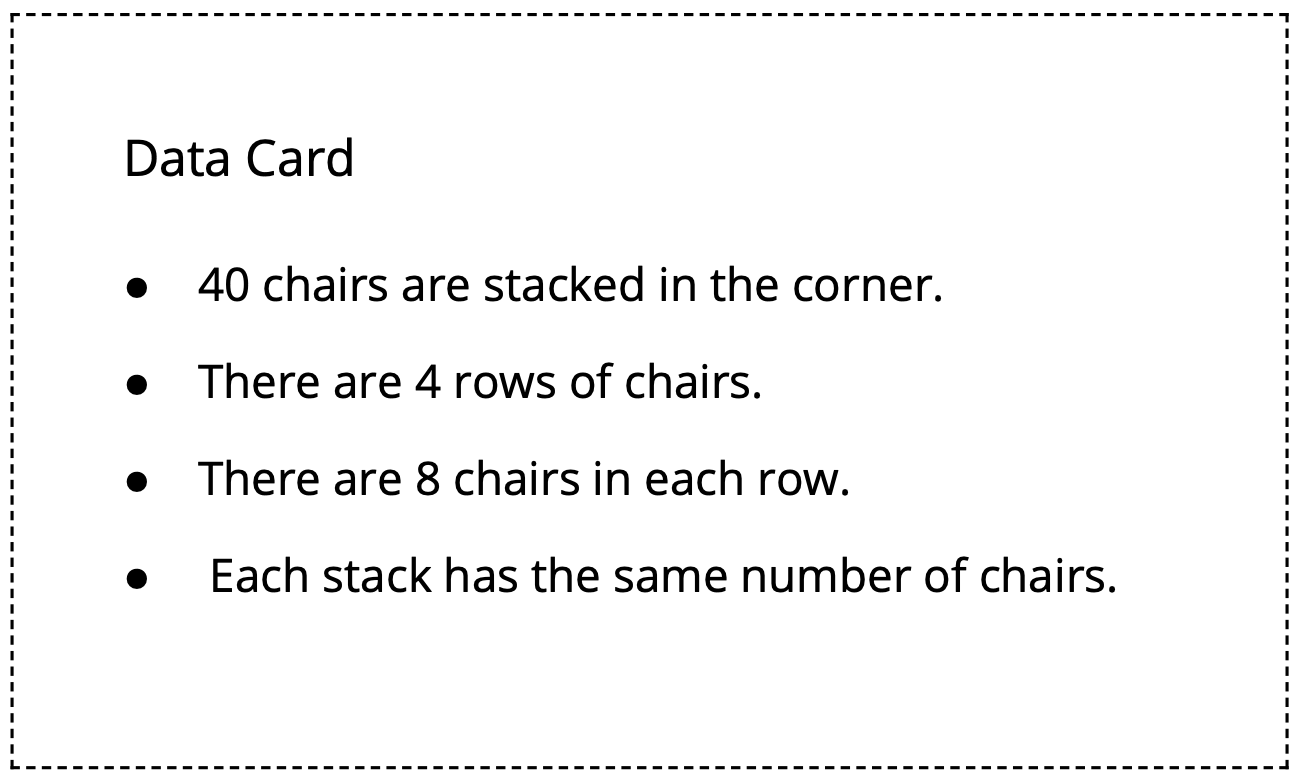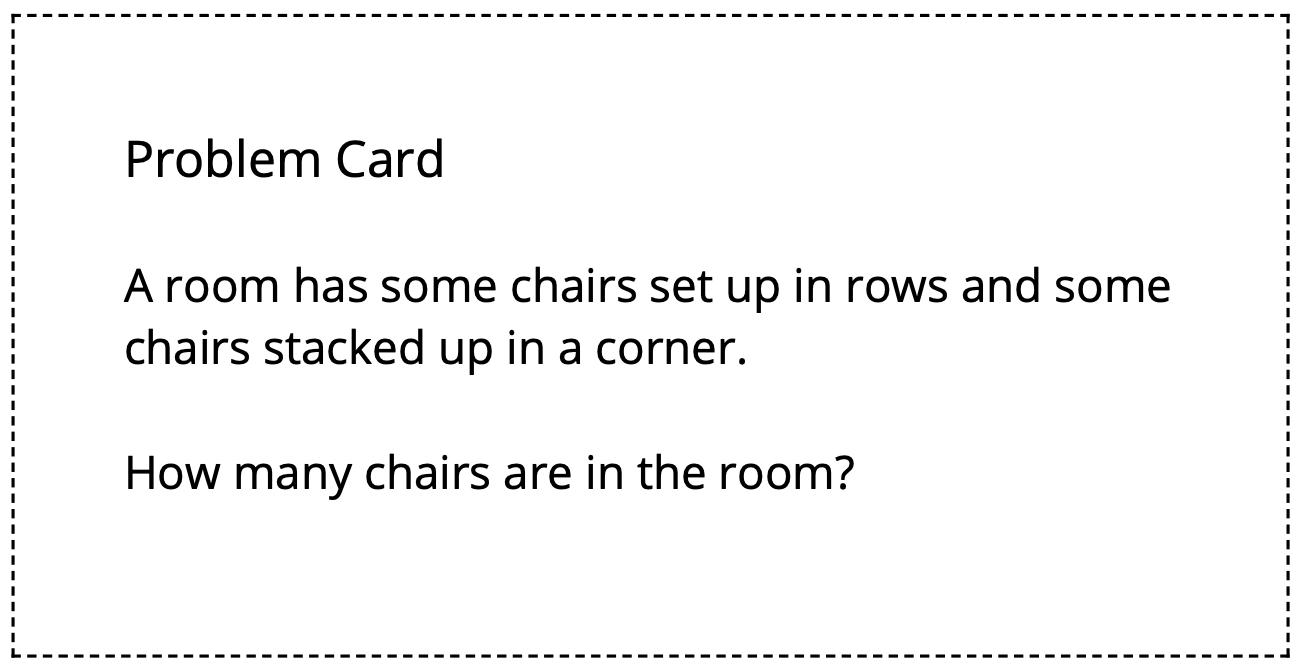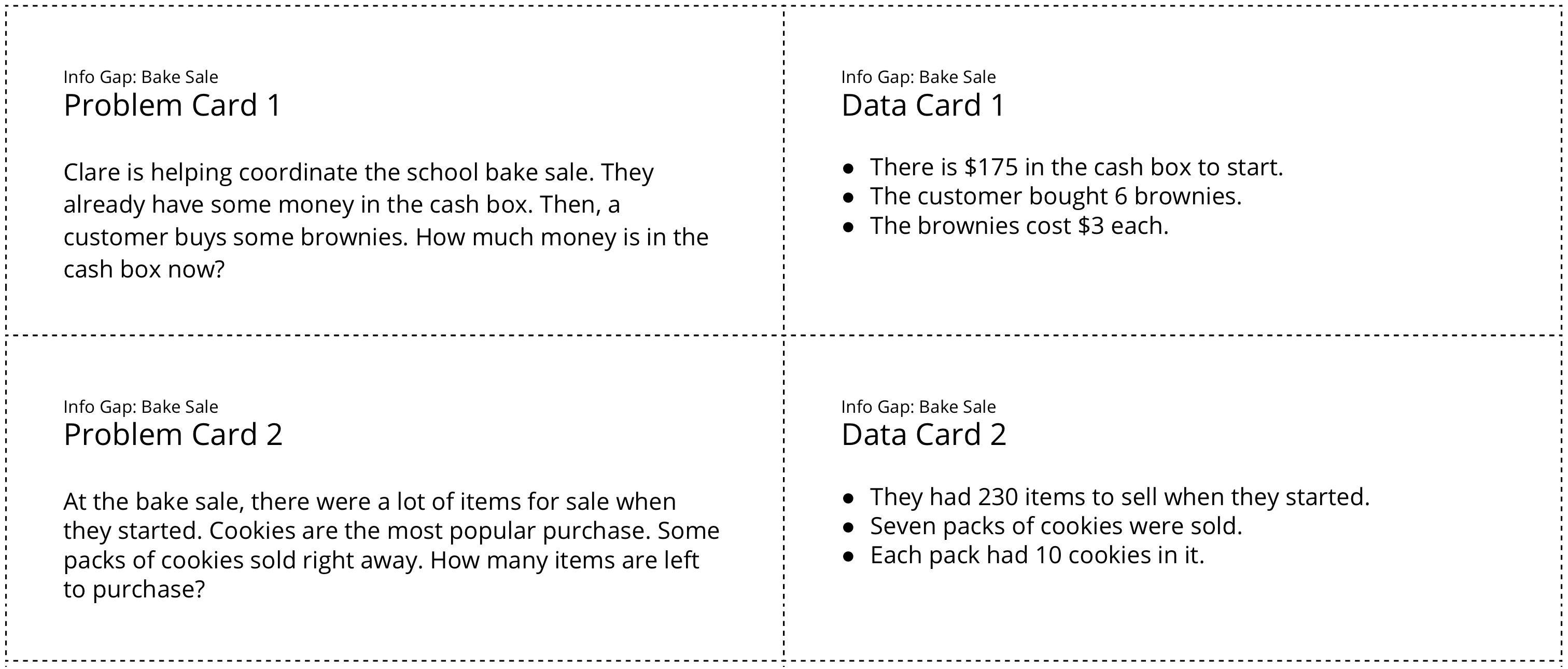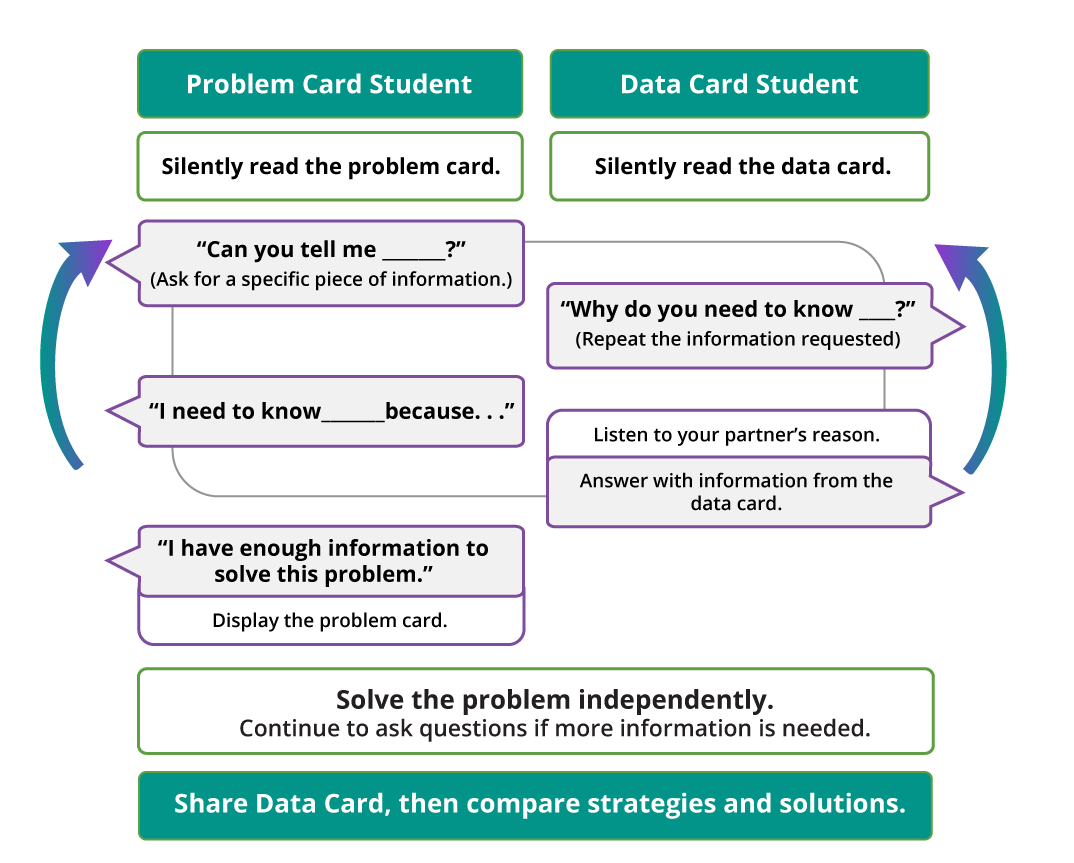Lesson 20
More Practice to Represent and Solve
Warm-up: Number Talk: Two Steps (10 minutes)
Narrative
The purpose of this Number Talk is to elicit strategies students have for multiplying single-digit factors and adding two-digit numbers. The expressions involve two operations. They encourage students to look for and make use of structure as they use their understanding of equal-size groups and properties of operations to find products and sums (MP7). The reasoning here will be helpful later when students solve two-step word problems.
Launch
- Display one expression.
- “Give me a signal when you have an answer and can explain how you got it.”
- 1 minute: quiet think time
Activity
- Record answers and strategy.
- Keep expressions and work displayed.
- Repeat with each expression.
Student Facing
Find the value of each expression mentally.
- \(20 + (2 \times 3)\)
- \(30 + (4 \times 3)\)
- \(50 + (8 \times 3)\)
- \(99 + (8 \times 3)\)
Student Response
For access, consult one of our IM Certified Partners.
Activity Synthesis
- “How did the first two expressions help you find the value of the last two expressions?”
- Consider asking:
- “Who can restate ___ 's reasoning in a different way?”
- “Did anyone have the same strategy but would explain it differently?”
- “Did anyone approach the problem in a different way?”
- “Does anyone want to add on to _____’s strategy?”
Activity 1: Info Gap: Introduction (15 minutes)
Narrative
The purpose of this activity is to introduce students to the structure of the MLR4 Information Gap routine. This routine facilitates meaningful interactions by positioning some students as holders of information that is needed by other students.
Tell students that first, a demonstration will be conducted with the whole class, in which they are playing the role of the person with the problem card. Explain to students that it is the job of the person with the problem card (in this case, the whole class) to think about what information they need to answer the question.
For each question that is asked, students are expected to explain what they will do with the information, by responding to the question, “Why do you need to know (that piece of information)?” If the problem card person asks for information that is not on the data card (including the answer!), then the data card person must respond with, “I don’t have that information.” In explaining their answers, students need to be precise in their word choice and use of language (MP6).
Once the students have enough information to solve the problem, they solve the problem independently.
The info gap routine requires students to make sense of problems by determining what information is necessary and then ask for information they need to solve them. This may take several rounds of discussion if their first requests do not yield the information they need (MP1).

Launch
- Groups of 2
- “The problems in this lesson are about setting up for a special event at a school. What’s your favorite special event at school or in your community?”
- Share responses.
Activity
MLR4 Information Gap
- Display the Sample Problem Card.
- Read the problem aloud.
- Listen for and clarify any questions about the context.
- “Some of the information you need to solve this problem is missing, and I have it here. What specific information do you need?”
- 1–2 minutes: quiet think time
- “With your partner, decide what information you need to solve the problem, and create a list of questions you can ask to find out.”
- 2–3 minutes: partner discussion
- Invite students to share 1 question at a time.
- Record each question on a display, and respond with: “Why do you need to know (restate the information requested)?” Students should provide a justification for how they will use the information before the information is revealed.
- Answer questions using only information stated on the Sample Data Card (do not reveal).
- Record information that is shared on the display. Give students time to decide whether they have enough information to solve the problem.
- Repeat until students decide they have enough information to solve, then ask students to solve.
- 2–4 minutes: independent work time
Student Facing

Student Response
For access, consult one of our IM Certified Partners.
Activity Synthesis
- Invite 1–2 students to share how they solved the problem.
- “Which questions helped you find out how many chairs were in the room?” (How many chairs were in the corner? How many chairs were in each row? How many rows were there?)
- If there were any questions that the data card cannot answer, discuss them here.
Activity 2: Info Gap: Bake Sale (20 minutes)
Narrative
This Info Gap activity gives students an opportunity to determine and request information needed to solve a two-step problem that involves multiplication.
The Info Gap structure requires students to make sense of problems by determining what information is necessary, and then to ask for information they need to solve it. This may take several rounds of discussion if their first requests do not yield the information they need (MP1). It also allows them to refine the language they use and ask increasingly more precise questions until they get the information they need (MP6).
Here is an image of the cards for reference:

Supports accessibility for: Social-Emotional Functioning, Memory
Required Materials
Materials to Copy
- Info Gap: Bake Sale
Required Preparation
- Create a set of cards from the blackline master for each group of 2.
- Keep set 1 separate from set 2.
Launch
- Groups of 2
MLR4 Information Gap
- Display the task statement, which shows a diagram of the Info Gap structure.
- 1–2 minutes: quiet think time
- Read the steps of the routine aloud.
- “I will give you either a problem card or a data card. Silently read your card. Do not read or show your card to your partner.”
- Distribute the cards.
- 1–2 minutes: quiet think time
- Remind students that after the person with the problem card asks for a piece of information the person with the data card should respond with “Why do you need to know (restate the information requested)?”
Activity
- 3–5 minutes: partner work time
- After students solve the first problem, distribute the next set of cards. Students switch roles and repeat the process with Problem Card 2 and Data Card 2.
Student Facing
Your teacher will give you either a problem card or a data card. Do not show or read your card to your partner.

Pause here so your teacher can review your work.
Ask your teacher for a new set of cards and repeat the activity, trading roles with your partner.
Student Response
For access, consult one of our IM Certified Partners.
Activity Synthesis
- “What kinds of questions were the most useful to ask?”
- Select 1–2 students to share different strategies used to solve one of the problems. Try to feature a student-drawn tape diagram.
- Consider asking:
- “Did anyone solve the problem in a different way?”
- “Did anyone use a tape diagram?”
- “How did you know if your answer made sense?”
- “How could we represent the second problem with an equation with a letter for the unknown quantity?” (\(230 - (7 \times 10) = {d}\))
Lesson Synthesis
Lesson Synthesis
“Today we learned the Information Gap routine. How did this routine help you make sense of the problems you solved?” (The routine gave me a chance to focus on what was important in the problem. I had to think about what I needed to know to solve the problem. I had to think about why some information was needed to solve the problem. It helped me make sense of what was happening in the problem.)
Cool-down: Reflection (5 minutes)
Cool-Down
For access, consult one of our IM Certified Partners.
Student Section Summary
Student Facing
In this section, we used rounding to estimate answers to problems. This helped us decide if our answers to problems made sense based on the situation and the numbers in the situation.
We also wrote equations with an unknown and used diagrams to solve for the exact answer in problems.
Situation:
Mai had 104 beads. She bought 2 more packs of beads and each pack has 10 beads in it. How many beads does she have now?
Diagram:

Equation with an unknown:
\(104+(2\times10)=n\)